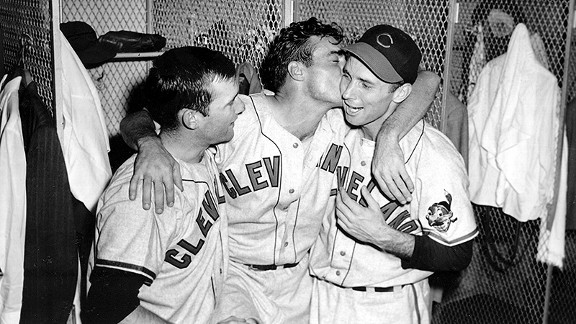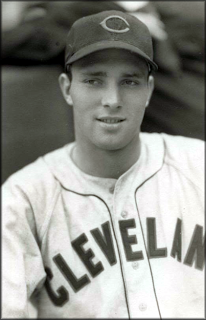 I’m frustrated. For all of my sentimental musings on the pastoral romance of baseball, I want a winner. Chances are you do too.
I’m frustrated. For all of my sentimental musings on the pastoral romance of baseball, I want a winner. Chances are you do too.
Yes, if you pressed me, I would admit the Cleveland Indians are having a better season in 2013 than I expected when it began. And sure, the future does appear bright, as the young ballplayers figure to get better. The current front office seems to be stocking the thin farm system. And OK, the final month of this season holds some promise for the Tribe. The schedule is chock full of last-place ball clubs.
I do wish to be more laid-back in my interest in sports. If it is an angst-ridden pursuit, what’s the point? I can get that at work. And of all the major sports, baseball lends itself to the enjoyment of ‘the process.’
But here I am, watching a Wild Card contender who unexpectedly cannot hit yet unexpectedly can pitch, sinking slowly away from the playoffs, and each loss is a little more disheartening.
I know: boo-hoo.
A commonly-held impression of Indians fans seems to be that our level of anxiety has been increasing incrementally every year, in a linear fashion, ever since the glorious 1948 World Series championship that nobody remembers.
We know it is a lot more nuanced than that. If we could quantify a Tribe fan’s ‘misery index’, the graph would show peaks and troughs over several decades (along an upward slope, sure).
There was even a time when the team was really good- a perennial Series contender- yet frustration had mounted anyway. From 1951 through 1956, the Indians won an average of 95 games a season. They won 111 in 1954, on their way to the league pennant. But in each of the other five seasons, they finished in second place. Behind the New York Yankees and out of the postseason.
By early 1957, several key components of that era had departed. Low-keyed manager Al Lopez was gone, as were pitcher Bob Feller, third baseman Al Rosen, 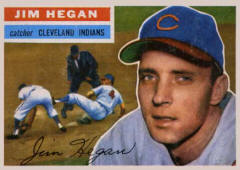 and center fielder Larry Doby. Others would soon be gone, as well. But for the time being, Early Wynn and Bob Lemon still led the pitching staff in their late 30s. Also held over were second baseman Bobby Avila, first baseman Vic Wertz, and the renowned relief tandem of Don Mossi and Ray Narleski (they even started a few dozen games).
and center fielder Larry Doby. Others would soon be gone, as well. But for the time being, Early Wynn and Bob Lemon still led the pitching staff in their late 30s. Also held over were second baseman Bobby Avila, first baseman Vic Wertz, and the renowned relief tandem of Don Mossi and Ray Narleski (they even started a few dozen games).
The 1957 Indians had clearly boasted the finest pitching staff in baseball for over ten years – since the end of World War II. The fact that they did finish as high as second place in 1956 with a team batting average of only .244 was a testament to the continued dominance of the pitching (which was bolstered by the sensational young lefty, Herb Score). One constant was the tutelage of pitching coach, and Indians lifer, Mel Harder. Another constant was catcher, and de facto pitching coach, Jim Hegan. This would be his final season with the team, as well.
Jim Hegan’s hitting statistics did not reflect his worth to the team. All of baseball accepted the superior skills he possessed in handling pitchers, calling a game, and fielding his position. A good example was Birdie Tebbetts. By now the manager of the Cincinnati Reds (and future manager of the Indians), Tebbetts’ big league catching career had spanned at least parts of three decades. He declared there had been no better player performing the duties of catcher than Jim Hegan.
His skills were something of legend. It was said that in the instant a foul ball was struck, Hegan would scramble to the point it would meet the field- without looking up for the ball. Apparently, that was true. His pitchers learned not to shake off his signs; when hitters struck out, it was said they often cursed Hegan. 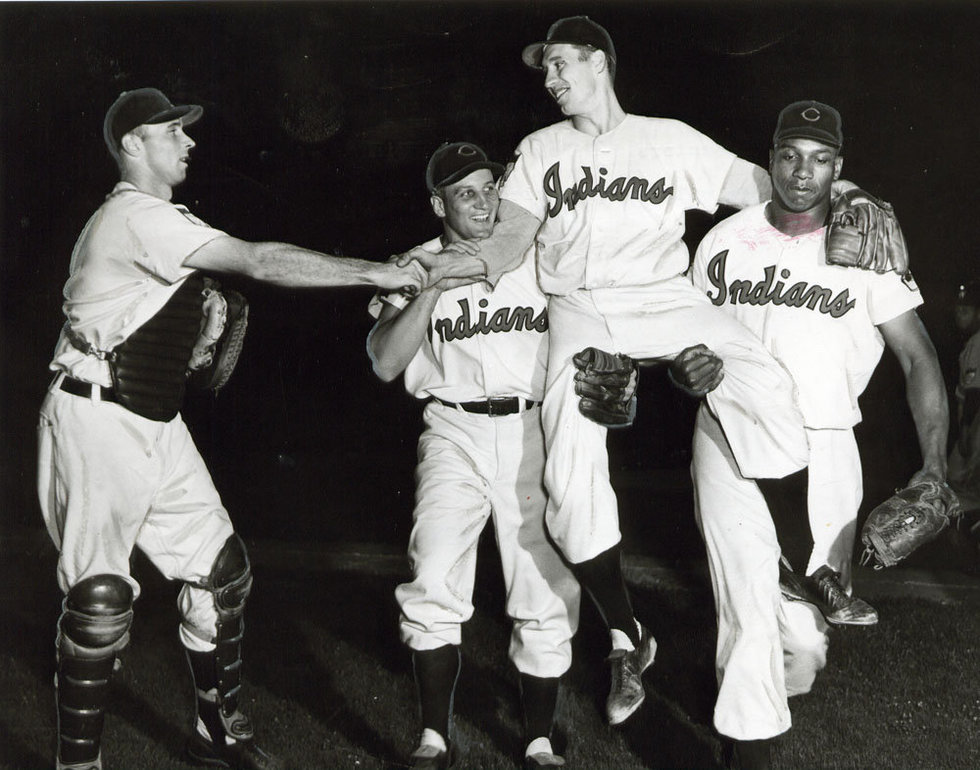 And base stealers challenged him at their own peril.
And base stealers challenged him at their own peril.
Interestingly, back in 1947, shortstop/manager Lou Boudreau pulled Hegan aside and told him he would call all pitches, using surreptitious signs while playing short. Hegan was to relay the call to the pitcher. It was a particularly tough time in Hegan’s career- especially when the secret was revealed at the end of the season. Since it bothered the catcher so much, Boudreau backed off and relinquished the duties in 1948- and the Indians won the World Series.
Hegan was an American League All Star five times between 1947 and 1952. He caught six 20-game winners: Gene Bearden, Bob Lemon, Bob Feller, Early Wynn, Mike Garcia and Herb Score. He caught no-hitters from Don Black, Lemon and Feller (photo with Feller being carried by Al Rosen and Luke Easter is from when he won his 20th in 1951).
Hegan’s quiet personality sometimes projected a first impression of arrogance. He was just very quiet, and naturally dignified. He was a little embarrassed when people made a big deal of his status as a major league baseball player, and his reaction caused others to consider him a bit aloof. I always like to remember which 1947 Indians befriended newcomer Larry Doby. The first black player in the American League, Doby never played in the minors (unlike Jackie Robinson). He came directly from the Negro leagues to the Cleveland Indians, so he had no previous friendships on the team. Along with such players as Steve Gromek, Joe Gordon, and Bob Lemon, Jim Hegan befriended Doby at a time when ignoring him would have been the easiest thing to do.
He was originally signed as an amateur free agent by the Indians in 1938 (photo at top may be from the 1930s). Hegan had been offered a tryout with manager 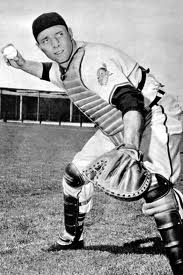 (and former catcher) Steve O’Neill on the suggestion of Hegan’s neighbor, a former Indian and teammate of O’Neill’s. According to Hegan’s wife, he was actually a better basketball player than baseball player. He played semi-pro hoops in the offseason, until Tribe owner Bill Veeck made him quit upon hearing he’d broken a bone in his hand. He made the big league club in 1941. He spent three years in the service during the war, before becoming a fixture behind the plate for the Tribe in 1946.
(and former catcher) Steve O’Neill on the suggestion of Hegan’s neighbor, a former Indian and teammate of O’Neill’s. According to Hegan’s wife, he was actually a better basketball player than baseball player. He played semi-pro hoops in the offseason, until Tribe owner Bill Veeck made him quit upon hearing he’d broken a bone in his hand. He made the big league club in 1941. He spent three years in the service during the war, before becoming a fixture behind the plate for the Tribe in 1946.
As the 1957 Indians took the field, hopes were still high that the pitching might carry the team to a pennant. A disappointing start featured, yes, a lack of production on offense. This included Jim Hegan, whom began platooning with two other catchers.
Let’s take a peek at a game in late April, in Kansas City against the Athletics- coincidentally, managed by Lou Boudreau. The Indians entered the game with a record of 2-4, and were going with Early Wynn on the mound. Wynn was looking for his first win of the season. The Tribe lineup boasted young Rocco Colavito, starting in right field. In left was another youngster, by the name of Roger Maris.
In the 1st, Athletics starter Wally Burnette worked around a one-out walk by inducing a strikeout/throwout double play against Maris and CF Al Smith.
Wynn had little trouble in the home half of the inning, getting two fly balls and a strikeout. AFTER ONE, 0-0.
In the Tribe 2nd, Wertz led off with a walk. Colavito fouled out to the catcher, and Avila flied out to center. 2B George Strickland singled to left, advancing 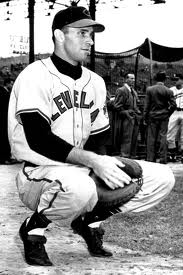 Wertz to second. Jim Hegan stepped up and delivered a double to left, scoring Wertz. Wynn grounded out.
Wertz to second. Jim Hegan stepped up and delivered a double to left, scoring Wertz. Wynn grounded out.
Wynn issued a leadoff walk of his own, before retiring the side with a ground ball force at second and a fly ball to Maris- the Indians doubled up the runner. AFTER TWO, 1-0 TRIBE.
Skipping ahead to the bottom of the 4th: Kansas City scored on the strength of three singles. AFTER FOUR, 1-1.
The starting pitchers took control of the game through the next couple innings. In the top of the 7th, Hegan led off with a walk. A ground ball out by Wynn pushed Hegan to second. Pinch hitter Gene Woodling then walked, and Al Smith singled to left. Hegan scored the go-ahead run. After Maris popped out to first, Wertz clobbered a double to straight away center field. Both runners scored.
Wynn held serve in the bottom of the 7th. AFTER SEVEN, 4-1 TRIBE.
The Indians added a run in the 8th: Strickland and Hegan each walked. Wynn moved the runners over with a bunt. Shortstop Chico Carrasquel scored Strickland with a sacrifice fly to right.
In the bottom of the 8th, Wynn was coasting with two outs before allowing a single/homer/double. He was lifted for reliever Ray Narleski, who completed the four-out save. INDIANS WIN, 5-3! Early Wynn was now 1-1; perhaps the Tribe was ready to settle down and start winning several games…
Unfortunately, the team would ultimately fade as the season played out. Tragically, and shockingly, Herb Score would be struck in the eye with a batted ball during a game, and would briefly fight for his life before beginning his recuperation. Kerby Ferrell would be fired after this one season as Indians manager. The offseason would usher in a new era of tumult and upheaval, led by newly hired general manager Frank “Trader” Lane. Gone would be more of the old guard, including Jim Hegan. Moving forward, nobody was safe from the fickle moves of Lane.
In Cleveland, the frustration was poised to spike.
Sources: Former Catcher Jim Hegan: Defense Was His Game, Baseball Digest, February, 1999, Bob Dolgan; baseball-reference.com; Wikipedia; www.findagrave.com; www.burningriverbaseball.com; www.thebaseballpage.com; www.oursportscentral.com; SIVault; www.letsgotribe.com, Top 100 Indians, #62, Steve O’Neill.
***Hey, follow me on Twitter! http://twitter.com/googleeph2 #thanks
Celebrating the 1948 Series win, with Gene Bearden and Bob Lemon.
